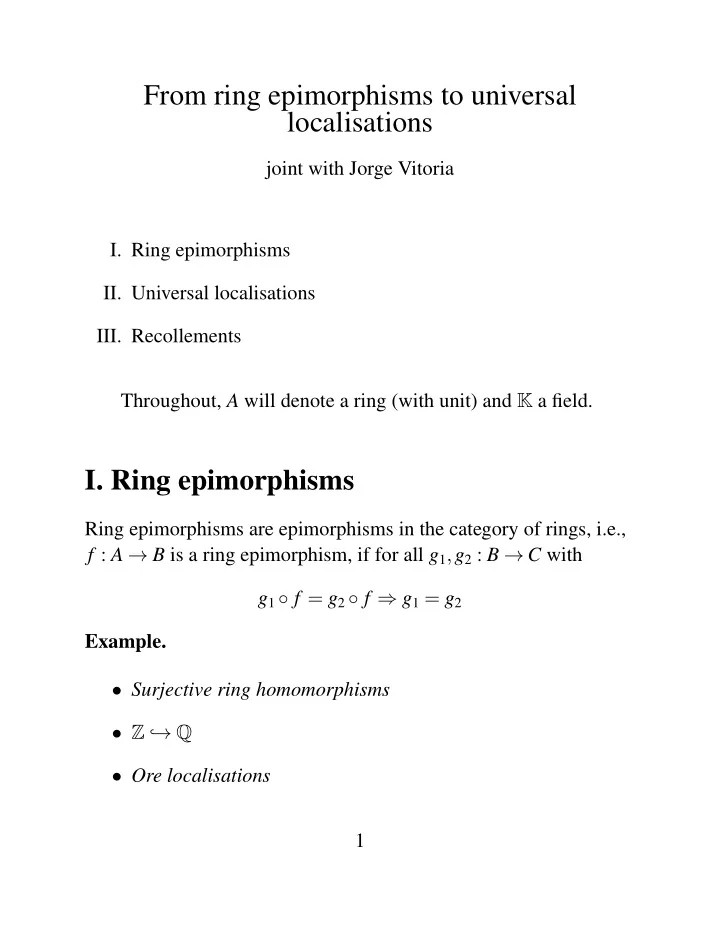

From ring epimorphisms to universal localisations joint with Jorge Vitoria I. Ring epimorphisms II. Universal localisations III. Recollements Throughout, A will denote a ring (with unit) and K a field. I. Ring epimorphisms Ring epimorphisms are epimorphisms in the category of rings, i.e., f : A → B is a ring epimorphism, if for all g 1 , g 2 : B → C with g 1 ◦ f = g 2 ◦ f ⇒ g 1 = g 2 Example. • Surjective ring homomorphisms • Z ֒ → Q • Ore localisations 1
Proposition (Stenström’75) . f : A → B a ring homomorphism. Then the following are equivalent. 1. f is a ring epimorphism. � A-Mod is fully faithful. 2. the restriction functor f ∗ : B-Mod 3. B ⊗ A coker ( f ) = 0 . A ring epimorphism f : A → B is called homological, if Tor A i ( B , B ) = 0 ∀ i > 0 . Proposition (Geigle-Lenzing’91) . f : A → B a ring homomorphism. Then the following are equivalent. 1. f is a homological ring epimorphism. 2. the derived restriction functor � D ( A ) : = D ( A-Mod ) D ( f ∗ ) : D ( B ) : = D ( B-Mod ) is fully faithful. 3. B ⊗ L A C f = 0 , where C f denotes the cone of f in D ( A ) . 2
� � � II. Universal localisations Definition/Theorem (Schofield’85) . Let Σ be a set of maps in A-proj. Then there is a ring A Σ − the universal localisation of A at Σ − and a ring homomorphism f Σ : A → A Σ such that i) A Σ ⊗ A σ is an isomorphism for all σ ∈ Σ . ii) For all ring homomorphisms g : A → B fulfilling i) there is g A B � � � � � � � � � � � � � f Σ ∃ ! h � � � A Σ Moreover, f Σ is a ring epimorphism and Tor A 1 ( A Σ , A Σ ) = 0 . Theorem (Krause-Stovicek’10) . Let A be a hereditary ring and f : A → B be a ring epimorphism. Then f is homological ⇔ f is a universal localisation. 3
Theorem (M.-Vitoria’12, Chen-Xi’12) . Let f : A → B be a ring epimorphism such that • A B is finitely presented • pd A B ≤ 1 Then f is homological if and only if f is a universal localisation. idea of the proof of ” ⇒ ” : I) C f ∼ g = ( P − 1 � P 0 f ) = : P f in D ( A ) with P f ∈ K b ( A - proj ) . f Since B ⊗ L A C f = 0, it follows that B ⊗ A g is an isomorphism. II) check universal property. Corollary. Let A be a finite dimensional K -algebra of the form • a group algebra of a finite group • a self-injective and representation-finite algebra Then finite dimensional homological ring epimorphisms f : A → B are universal localisations, turning A B into a projective A-module. 4
� � � � � � � � III. Recollements f � B yields a "semiorthogonal A homological ring epimorphism A decomposition" of D ( A ) into smaller triangulated categories. (recollement) D ( f ∗ ) � D ( A ) � TriaC f D ( B ) Theorem (M.-Vitoria’12) . Let f : A → B be a homological ring epimorphism such that • A B is finitely presented • pd A B ≤ 1 • Hom A ( coker ( f ) , ker ( f )) = 0 Then there is a recollement D ( f ∗ ) � D ( A ) � D ( End D ( A ) ( C f )) . D ( B ) Furthermore, if A B is projective, we have an isomorphism of rings End D ( A ) ( C f ) ∼ = A / τ B ( A ) , where τ B ( A ) denotes the trace of A B in A. 5
Recommend
More recommend